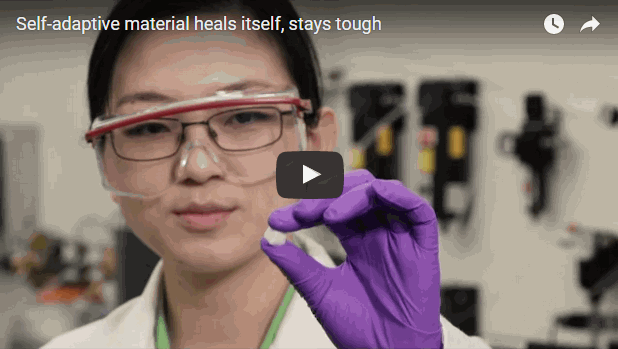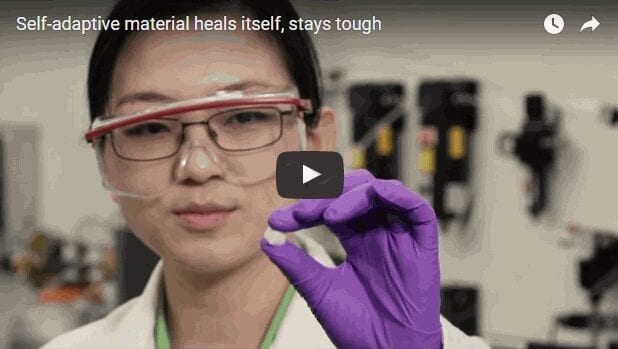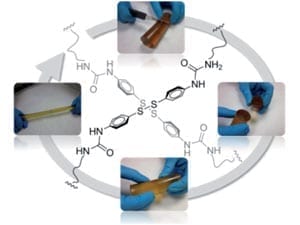
An adaptive material invented at Rice University combines self-healing and reversible self-stiffening properties.
The Rice material called SAC (for self-adaptive composite) consists of what amounts to sticky, micron-scale rubber balls that form a solid matrix. The researchers made SAC by mixing two polymers and a solvent that evaporates when heated, leaving a porous mass of gooey spheres. When cracked, the matrix quickly heals, over and over. And like a sponge, it returns to its original form after compression.
The labs of Rice materials scientists Pulickel Ajayan and Jun Lou led the study that appears in the American Chemical Society journal ACS Applied Materials and Interfaces. They suggested SAC may be a useful biocompatible material for tissue engineering or a lightweight, defect-tolerant structural component.
Other “self-healing” materials encapsulate liquid in solid shells that leak their healing contents when cracked. “Those are very cool, but we wanted to introduce more flexibility,” said Pei Dong, a postdoctoral researcher who co-led the study with Rice graduate student Alin Cristian Chipara. “We wanted a biomimetic material that could change itself, or its inner structure, to adapt to external stimulation and thought introducing more liquid would be a way. But we wanted the liquid to be stable instead of flowing everywhere.”
In SAC, tiny spheres of polyvinylidene fluoride (PVDF) encapsulate much of the liquid. The viscous polydimethylsiloxane (PDMS) further coats the entire surface. The spheres are extremely resilient, Lou said, as their thin shells deform easily. Their liquid contents enhance their viscoelasticity, a measure of their ability to absorb the strain and return to their original state, while the coatings keep the spheres together. The spheres also have the freedom to slide past each other when compressed, but remain attached.
“The sample doesn’t give you the impression that it contains any liquid,” Lou said. “That’s very different from a gel. This is not really squishy; it’s more like a sugar cube that you can compress quite a lot. The nice thing is that it recovers.”
Ajayan said making SAC is simple, and the process can be tuned – a little more liquid or a little more solid — to regulate the product’s mechanical behavior.
“Gels have lots of liquid encapsulated in solids, but they’re too much on the very soft side,” he said. “We wanted something that was mechanically robust as well. What we ended up with is probably an extreme gel in which the liquid phase is only 50 percent or so.”
Read more: Self-adaptive material heals itself, stays tough
The Latest on: Self-adaptive material
[google_news title=”” keyword=”self-adaptive material” num_posts=”10″ blurb_length=”0″ show_thumb=”left”]
via Google News
The Latest on: Self-adaptive material
- UPSC CSE 2024: 6 Strategies to Revise Syllabus for Students Without Coachingon April 26, 2024 at 11:06 pm
The journey towards mastery often begins with effective revision strategies, especially for students navigating their syllabi independently, without t ...
- My Top Picks for Best Enrolled Agent Continuing Education Courseson April 26, 2024 at 3:40 am
Pricing: Lambers offers a 1-Year All Access Continuing Education package priced at $499.95, which provides unlimited access to their extensive course catalog. However, it’s important to note that this ...
- Android versions: A living history from 1.0 to 15on April 26, 2024 at 2:48 am
Explore Android's ongoing evolution with this visual timeline of versions, starting B.C. (Before Cupcake) and going all the way to 2024's Android 15 (beta) release.
- If You Work From Home, Here’s 6 Tips To Create The Perfect WFH Officeon April 23, 2024 at 8:31 pm
Whether you have a dedicated home office or a space carved out in the living room, these tips can help to make it stylish, functional, and ergonomic.
- Which Office Buildings Are Strong Candidates for Adaptive Reuse?on April 23, 2024 at 6:06 am
With office occupancy still well below pre-pandemic levels due to the prevalence of the hybrid work model and companies downsizing their space needs, property owners are resorting to creative ...
- The 2025 Cadillac CT5: A midsize luxury car for compact luxury car budgetson April 23, 2024 at 2:05 am
Cadillac CT5 midsize luxury sedan is revamped this year, making it a more credible contender in a class full of great cars.
- Eureka Ergonomic Python II Gaming Chair Reviewon April 22, 2024 at 6:01 pm
The Eureka Ergonomic Python II has been slithering its way into more gaming rooms. Find out what makes this ergonomic gaming chair so unique.
- Don’t believe the naysayers: Hybrid remote work is improving employees’ mental healthon April 22, 2024 at 8:00 am
States with high or median flexibility levels for remote work had 3 percent to 4 percent lower depression rates than those with low flexibility in 2023.
- Commentary: LACMA finally is getting its satellite space. Regrettably, it’s in another stateon April 22, 2024 at 3:00 am
LACMA's collection will be loaned to a new Las Vegas art museum. The deal isn't a jackpot for L.A., which has long been promised its own satellites.
- The 2025 BMW Z4: This quick and agile luxury sports car drives with flairon April 22, 2024 at 2:03 am
BMW Z4 is a luxury sports car with speed, agility, and class. It’s good at what it does, and it’s not just a weekend toy.
via Bing News











